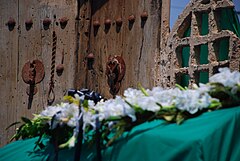Fatimiyya
| Fatimiyya | |
|---|---|
 Fatimiyya in Tehran | |
| Official name | فاطمیه |
| Observed by | Shia |
| Type | Muslim, Shia |
| Significance | Mourning for the martyrdom of Fatimah |
| Date | First Fatimiyya 13–14 Jumada al-awwal Second Fatimiyya 3–5 Jumada al-Thani |
| Frequency | Once every Year (per year) |
| Related to | Attack on Fatimah's house |
| Part of a series on Shia Islam |
|---|
 |
|
|
Fatimiyya (Arabic: فاطمیة) are days in which Shia Muslims mourn the martyrdom of Fatimah, daughter of the Islamic prophet Muhammad.[1][2][3] Fatimiyya is the window between the two possible dates for her death, that is, from 13 Jumada al-Awwal to 3 Jumada al-Thani. In particular, the Fatimiyya period is a total of six days, three days in the month of Jamadi al-Awal and three days in the month of Jumada al-Thani. That is, the first Fatimiyya is 13–15 Jumada al-Awwal and the second Fatimiyya is 3–5 Jamadi al-Thani.[4][5] Instead of three, some Shia Muslims mourn for ten days.[6]
Time of mourning
Whilst there is no established convention, periods of Fatimiyya such as "the first ten days" (10–20 Jumada al-Awwal) or "the second ten days" (1–10 Jumada al-Thani) are in recent years increasingly commemorated by Shia Muslims much like the first ten days of Muharram, which are traditionally associated with the martyrdom of Husayn. The prominent place of Fatimah in Islam as daughter of Islamic prophet Muhammad, the hardships she endured in her short life, and that she gave her life to defend the first Shia Imam, Ali, are among the reasons Shia Muslims give for the annual remembrance of Fatimah.[7][8]
Fatimiyya in other countries
Apart from Iran and Iraq, Fatimiyya is also observed in other countries, including India, Pakistan,[9] Australia,[10] Azerbaijan, and Tajikistan.[11] There are also events organized in Europe by the Islamic Centre of Hamburg in Germany,[12] the Islamic Centre of England, and others in Sweden and elsewhere.[13]
Differences in date
The uncertainty about when Fatimah died is often attributed to multiple factors:
- In early Islam, historical events were remembered orally—not in written—which might have led to discrepancies.
- Muslim civil wars might have meant less attention and care in preserving historical records.[14][15]
- The Arabic script initially lacked any symbols, including punctuation and diacritic.[16] For this reason, seventy (Arabic: سبعون) and ninety (Arabic: تسعون) were written identically, creating a source of ambiguity for later historians who received the narration, "She [Fatimah] died when she was eighteen years old and seventy five days."[17]
- The probability of distortion by partial individuals.[18]
See also
References
- ^ ‘Fatimiyyah means to oppose the chiefs of oppression…’ Archived 2018-05-26 at the Wayback Machine al-islam.org Retrieved 10 May 2018
- ^ “Fāṭimiyyah is ʿĀshūrāʾ” islamicblessings.com Retrieved 10 May 2018
- ^ The beginning and end date of Fatemiye in this year namnak.com Retrieved 10 May 2018
- ^ "در مورد ایام فاطمیه در ویکی تابناک بیشتر بخوانید". www.tabnak.ir. Retrieved 2021-12-21.
- ^ "شروع و پایان ایام فاطمیه چه زمانی است؟" [When is the beginning and end of the Fatimiyya?]. YJC (in Persian). 2020-01-12. Retrieved 2021-12-21.
- ^ Tabrizi, Sire (Manner) of Mirza Javvad Atbrizi, pp. 88–92
- ^ Mazaheri, Andishehay Naab (pure thoughts), p. 103
- ^ Tabrizi, Sire (Manner) of Mirza Javvad Atbrizi, pp. 88–92
- ^ The days of the martyrdom of Hadhrat Fatimah al-Zahra (peace be upon her) in Pakistan irna.ir Retrieved 10 May 2018
- ^ The mourning ceremony of the second Fatimiyya in Australia fa.abna24.com Retrieved 10 May 2018
- ^ The martyrdom of Hazrat Fatimah Zahra (a.s.) tajik.irib.ir Retrieved 10 May 2018
- ^ Fatimiyyah days www.shia-news.com Retrieved 10 May 2018
- ^ I am the mourner of Fatimah Archived 2018-05-27 at the Wayback Machine eghtesadbartar.com Retrieved 10 May 2018
- ^ The reason of being differences in the date of Hazrat Zahra's (a.s.) martyrdom kayhan.ir Retrieved 26 May 2018
- ^ Fatimah al-Zahra (a.s.) tasnimnews.com Retrieved 26 May 2018
- ^ "تاریخچه رسم الخط قرآن و سیر و تحول آن" [History of Quran calligraphy and its evolution]. quran.isca.ac.ir (in Persian). Retrieved 2021-12-21.
- ^ "چرا دو دهه ایام فاطمیه داریم؟" [Why we have to Fatimiyya?]. YJC (in Persian). 2017-02-22. Retrieved 2021-12-21.
- ^ Shahidi, Seyyed jafar, The life of Fatima-Zahra (a.s.), Tehran, Publishing office of Islamic culture, p. 155
